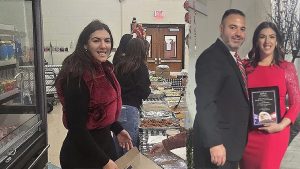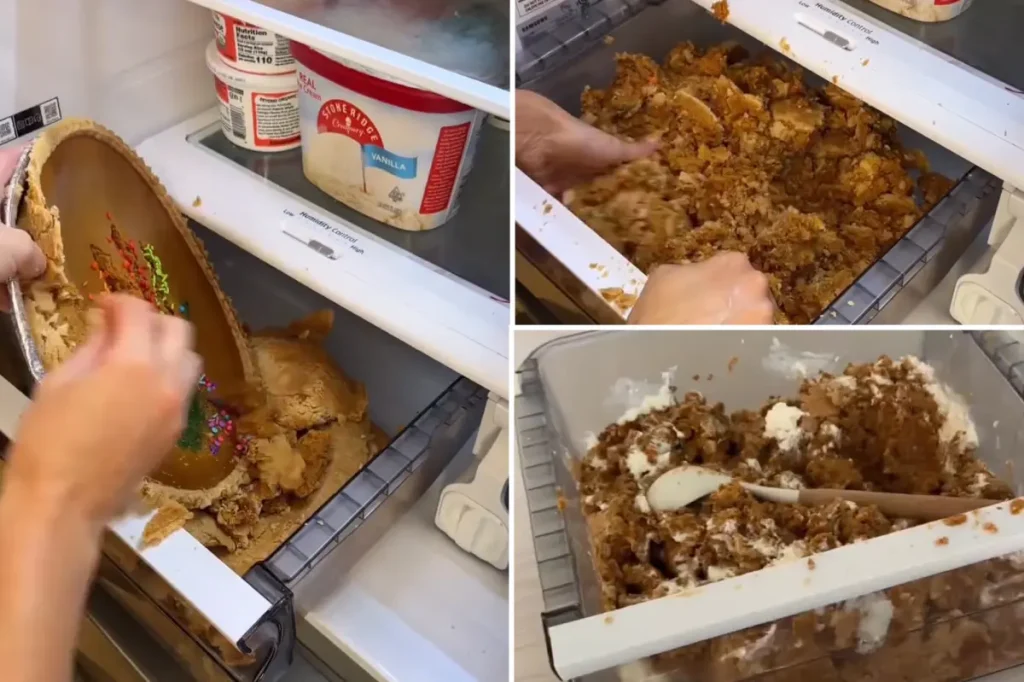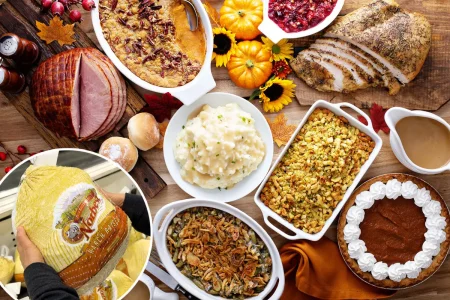From Pie Drawer to Viral Sensation: The Story of Kate Heintzelman’s Unconventional Thanksgiving Hack
Content creator Kate Heintzelman sparked an online firestorm with her unorthodox approach to serving pumpkin pie during the holiday season. The 33-year-old Minnesotan’s video, which garnered nearly 5 million views across her Instagram and TikTok accounts (@katewilltryanything), showcased what many considered an outrageous method: smashing four pumpkin pies directly in her refrigerator drawer, mixing them by hand, adding an entire can of whipped cream, and then serving the concoction with an ice cream scoop. The internet’s reaction was swift and divided, with critics calling her approach “gross,” “pure nastiness,” and “wrong on so many levels.” Despite the backlash, Heintzelman’s quirky food preparation style succeeded in capturing the attention of millions, continuing her streak of viral refrigerator drawer creations that previously featured seven-layer salsa and spaghetti with meatballs.
What inspired such an unconventional approach to a traditional holiday dessert? Heintzelman, a former high school social studies teacher who launched her content creation career during the pandemic, explained that convenience was the driving factor. “I had put other stuff in the fridge before for easy convenience,” she told The Post. “And I thought, ‘What about a pumpkin pie?’ Because I feel like everybody’s cooking all day long. And if you could just have the pumpkin pie in the fridge already ready, that seems easy.” For her now-infamous creation, she purchased four pumpkin pies and a can of whipped cream from Costco, transforming them into what might be described as a deconstructed pumpkin pie trifle—albeit one served from an unusual vessel.
The criticism came in waves, with many commenters expressing concern about food waste. “It’s really sickening to see all this food waste in these critical times when people are literally starving,” wrote one commenter, a sentiment that over 3,000 others endorsed with likes. Heintzelman responded to these concerns with pragmatism: “I always think those comments are interesting because you’re like, ‘Okay, well, in the grand scheme of things, they’re like $5 each maybe,'” she noted. She also pushed back against the implication that she was being callous about food insecurity, adding, “And I always think, like, ‘Well, how much money do you guys give to the poor?’ I donate money to food shelters.” Her response highlights the complex relationship between social media food content, entertainment, and genuine concerns about consumption ethics.
Sanitation was another major point of contention among viewers. Comments like “Does she know how many bacteria can grow in your fridge without knowing it” and “Food also has a refrigeration taste when left uncovered” reflected genuine food safety concerns. Others specifically criticized her hand-mixing technique, questioning, “Why put your dirty hands all over that pie?” Heintzelman addressed these criticisms with both reassurance and a touch of humor. She confirmed that she thoroughly cleaned the drawer beforehand and insisted that the refrigeration didn’t affect the taste: “It tasted like pie still. It’s not like it was there for days, you know what I mean?” As for using her hands, she challenged the critics: “I washed my hands, you guys, how do you cook at your house? Do you all wear rubber gloves when you cook for everybody? That can’t be true.” Even Scotch-Brite’s official Instagram account joined the conversation with a humorous comment: “I feel like you’ll need me later,” though Heintzelman maintained that cleanup was “super easy.”
Perhaps most tellingly, some commenters suggested that Heintzelman’s approach reinforced their decision to avoid potluck-style gatherings during the holidays. “That’s why I do not do potlucks,” one person remarked, while another added, “This is why you can’t eat at just anyone’s house. People are nasty!!” These comments reveal how deeply personal food preparation can be and how strongly people feel about proper food handling and presentation. What Heintzelman viewed as a convenient and potentially fun way to serve dessert, many interpreted as a breach of unwritten social rules about food service etiquette—particularly during a holiday season when traditional presentation often carries significant cultural weight.
What makes this story particularly interesting is how it represents the evolution of food content on social media. Heintzelman’s viral moment wasn’t created through a meticulously styled food photograph or a complex recipe requiring specialized ingredients. Instead, it was the deliberate subversion of expectations—the transformation of something familiar (pumpkin pie) through an unexpected presentation method—that captured people’s attention. Whether viewed as a clever hack for busy hosts or a culinary abomination, Heintzelman’s refrigerator drawer pie certainly accomplished what successful content often aims to do: it got people talking. In an era when social media algorithms reward engagement of all kinds, even outraged comments help propel content to wider audiences. Heintzelman’s pie drawer experiment stands as a perfect case study of how food content creators navigate the fine line between innovation and provocation, often finding viral success precisely at the point where tradition meets disruption.















